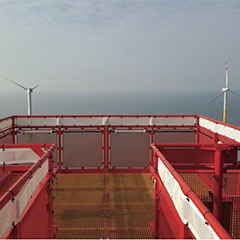We all know the importance of a good pit crew during a pit stop in a race. Team members work closely together to have the racecar optimized and back on the track as soon as possible. The same idea and spirit for service teams apply to wind turbines.
ZF Wind Power’s service organization works closely together with wind turbine manufacturers, end users, and independent service providers to keep wind turbines up and running. Digitalization is a major facilitator of this unique service approach.
Life in service: onshore, offshore, up-tower, in a workshop, under any circumstances and powered by analytics
Wind farms are located in areas with diverse geographical and meteorological characteristics, so service teams need to be able to work on them under any circumstances.
ZF Wind Power service teams are located in all wind hotspot markets and our technicians are trained to handle both down-tower workshop repairs as well as challenging up-tower interventions at different locations and in various situations.
Onshore teams experience heat in the deserts, snow in the mountains, and fog in the wetlands. Offshore technicians will carry out airborne or amphibious interventions.
But service is not limited to outdoor corrective service interventions alone. It starts with the integration of cloud-based digital data that can be monitored remotely.
‘Services powered by Analytics’ to reduce the cost of wind energy
‘Services powered by Analytics’ is ZF Wind Power’s vision to reduce the OPEX, increase the output and availability, and extend wind turbine lifetime.
In order to create a stable basis for optimized services, it is important to know all the data that relate to the production of every single gearbox. Every gearbox that leaves ZF Wind Power’s plants is logged with a unique dataset that we call the ‘Digital Birth Certificate’.
This certificate covers as-built gearbox information and contains data such as individual gearbox configuration, component traceability, and design models.
In addition to gearbox data, gearbox expertise is key: knowing what can go wrong and how to fix it. The combination of these data with wind turbine performance data is called the Life Cycle Monitor.
The enriched dataset is then subjected to Life Cycle Analytics. These analytics provide lifetime predictions and alert-based recommendations supporting the decision-making concerning operations & maintenance (O&M) activities and the execution thereof. This process is key to optimizing services and reducing the levelized cost of energy (LCOE).



























